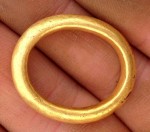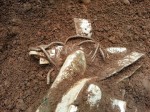 Retired businessman Derek McLennan was sick and really didn’t feel like dragging his carcass and his metal detector to a Church of Scotland field near Castle Douglas in Dumfries and Galloway, Scotland, last month. He didn’t want to disappoint his detecting buddies the Reverend David Bartholomew and Mike Smith, pastor of Elim Pentecostal Church, however, so he pulled it together and off they went. After an hour of searching, McLennan found a piece of silver buried two feet under the surface. At first he thought it was a spoon, but when he wiped some of the dirt off it, he saw a saltire (X marks the spot) design and realized he’d unearthed Viking treasure.
Retired businessman Derek McLennan was sick and really didn’t feel like dragging his carcass and his metal detector to a Church of Scotland field near Castle Douglas in Dumfries and Galloway, Scotland, last month. He didn’t want to disappoint his detecting buddies the Reverend David Bartholomew and Mike Smith, pastor of Elim Pentecostal Church, however, so he pulled it together and off they went. After an hour of searching, McLennan found a piece of silver buried two feet under the surface. At first he thought it was a spoon, but when he wiped some of the dirt off it, he saw a saltire (X marks the spot) design and realized he’d unearthed Viking treasure.
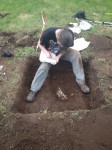 McLennan reported the find to Scotland’s Treasure Trove Unit and soon Galloway Council archaeologist Andrew Nicholson was on the scene excavating dozens of silver ingots, decorated arm rings and a solid silver cross with enamel decoration from the find spot. When the artifacts were fully excavated, McLennan ran his machine over the hole again and again got a signal. More digging unearthed a second layer of treasure, including a silver Carolingian pot complete with its lid that is one of only three of its kind ever found in Britain.
McLennan reported the find to Scotland’s Treasure Trove Unit and soon Galloway Council archaeologist Andrew Nicholson was on the scene excavating dozens of silver ingots, decorated arm rings and a solid silver cross with enamel decoration from the find spot. When the artifacts were fully excavated, McLennan ran his machine over the hole again and again got a signal. More digging unearthed a second layer of treasure, including a silver Carolingian pot complete with its lid that is one of only three of its kind ever found in Britain.
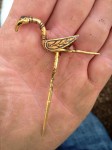 All told, the hoard proved to include more than a 100 individual pieces. It’s the largest Viking treasure found in Scotland since 1891, and there’s the possibility of more to come when the silver pot is opened and its contents excavated in the lab. The array of artifacts — stamp-decorated bracelets from Ireland, glass beads from Scandinavia, a beautifully graceful gold bird-shaped pin or hair ornament, silver ingots marked with runic inscriptions, even textile fragments still attached to the Carolingian pot — make this a find of international importance.
All told, the hoard proved to include more than a 100 individual pieces. It’s the largest Viking treasure found in Scotland since 1891, and there’s the possibility of more to come when the silver pot is opened and its contents excavated in the lab. The array of artifacts — stamp-decorated bracelets from Ireland, glass beads from Scandinavia, a beautifully graceful gold bird-shaped pin or hair ornament, silver ingots marked with runic inscriptions, even textile fragments still attached to the Carolingian pot — make this a find of international importance.
Describing the find as “historically significant”, Stuart Campbell, head of Scotland’s treasure trove unit, said one of the most exciting objects was an intact Carolingian (western European) pot with its lid still in place, a rare vessel likely to have been an heirloom held by the family that buried the hoard. Campbell described the examination of the pot, which has yet to be emptied, as “an excavation in microcosm”.
He added: “What makes this find so significant is the range of material from different countries and cultures. This was material that was buried for safekeeping, almost like a safety deposit box that was never claimed.”
Campbell said that a find like this could also influence the way Scots viewed their historic relationship with the Vikings. “We have the idea of Vikings as foreigners who carried out raids on Scotland, but this was a Viking area where they settled and traded, and the people who lived there were culturally and linguistically Norse.”
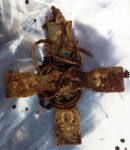 The hoard was buried in the 9th or 10th century. The silver cross dates to around that time. Its unusual enamel decoration is figural, possibly depictions of the four evangelists on each arm of the cross. The pot was already at least a hundred years old when it was buried, hence archaeologists’ belief that it may have been a family heirloom. Researchers hope the contents might reveal more information about who buried the treasure under what circumstances.
The hoard was buried in the 9th or 10th century. The silver cross dates to around that time. Its unusual enamel decoration is figural, possibly depictions of the four evangelists on each arm of the cross. The pot was already at least a hundred years old when it was buried, hence archaeologists’ belief that it may have been a family heirloom. Researchers hope the contents might reveal more information about who buried the treasure under what circumstances.
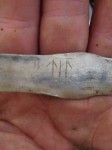 The discovery is governed by the Scottish law of treasure trove which claims the artifacts for the public trust, while rewarding the finder and landowner with a sum equivalent to fair market value of the finds. In this case, early estimates put the value at £1 million, but that could change once the artifacts are examined more closely and the contents of the pot assessed. The landowners, the Church of Scotland General Trustees, and Derek McLennan have already come to an agreement on sharing the reward equally. The Church’s portion will be dedicated to the local parish.
The discovery is governed by the Scottish law of treasure trove which claims the artifacts for the public trust, while rewarding the finder and landowner with a sum equivalent to fair market value of the finds. In this case, early estimates put the value at £1 million, but that could change once the artifacts are examined more closely and the contents of the pot assessed. The landowners, the Church of Scotland General Trustees, and Derek McLennan have already come to an agreement on sharing the reward equally. The Church’s portion will be dedicated to the local parish.
This Reuters story has some beautiful close-ups of highly decorated gold and silver pieces. I’d embed it but it has an unkillable autoplay. :angry:
